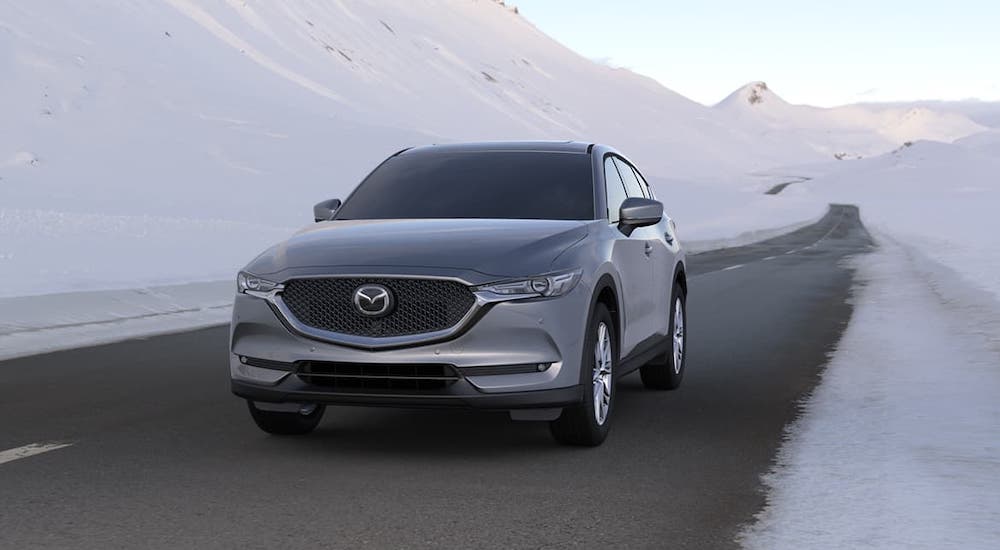We often think of a crossover as an artist that has a song become popular with two different crowds, like a country song rising the pop charts. When this happens, the musical artist is thought of as having crossed over, appealing to both country music and pop music fans. It is not easy to successfully do, and the concept of crossover vehicles is no different. The idea is to design a vehicle that will appeal to drivers of sedans and SUVs, delivering the value proposition that each driver seeks when buying a car. It is not an easy task, but some manufacturers have figured it out. And today, we are going to look at the best of the best in a comparison: 2020 Honda CR-V vs 2020 Mazda CX-5.
Initially, when looking at these two, we see two well-built crossover vehicles with room for up to five passengers. Each comes front-wheel drive standard with available all-wheel drive and features the respective infotainment system from their respective manufacturer, each on an easy-to-use color touchscreen. However, there are some key differences between the two, including price, performance, and features that we are going to explore today.
MSRP and Trims
For starters, both of these crossovers are relatively affordable options and offer multiple trims to choose from, which is definitely important. The 2020 Honda CR-V comes in four different trims. The base model is the LX with an MSRP of $25,050. This is followed by the EX with an MSRP of $27,560, the EX-L with leather seats and MSRP of $30,050, and the top-of-the-line Touring with an MSRP of $33,250.
In contrast, the 2020 Mazda CX-5 has five trims. The entry trim is the Sport with an MSRP of $25,190. The next trim is the Touring with an MSRP of $26,830, followed by the Grand Touring with an MSRP of $30,310, the Grand Touring Reserve with an MSRP of $35,135, and the fully loaded Signature with an MSRP of $37,155. The Grand Touring Reserve and Signature are only available in all-wheel drive.
The first thing you probably noticed is that they both have a Touring trim. However, the Touring on the Honda is the top-level, while on Mazda, it is only the second level. Sorry if this caused you any confusion; they are not related. The second thing you probably noticed is that the price point on the Honda is lower. Aside from the base model costing a little less than the Mazda, you can purchase the top Honda CR-V trim for less than a Mazda CX-5 Grand Touring Reserve, which is not even the top trim. So while Mazda has one extra trim level, you can get a top Honda CR-V for a lot less.
How Do They Perform?
Beyond price, the performance of a crossover is one of the most important factors to consider. Honda offers one engine option on the 2020 Honda CR-V, a 1.5T in-line 4-cylinder engine. This engine is paired with a continuous variable automatic transmission (CVT) and produces 190 hp and 179 lb-ft of torque. All the while, in comparison, the 2020 Mazda CX-5 offers two engines. The standard engine is a SKYACTIV-G 2.5-liter DOHC16-valve 4-cylinder engine that produces up to 187 hp and 186 lb-ft of torque. And this can be upgraded to a more powerful SKYACTIV-G 2.5T dynamic pressure turbo DOHC 4-cylinder engine with variable valve timing VVT that engine produces 227-250 hp and 310-320 lb-ft of torque. And both of the Mazda engines are paired with a SKYACTIV DRIVE 1 6-speed automatic transmission.
The Mazda with the 2.5T engine has the best pickup of these three engines, with the Honda outperforming the Mazda 2.5-liter engine. However, all of that power comes at a massive cost. In addition, the CVT on the Honda gives the overall drive a smoother feel than either of the Mazda engines, making it the better vehicle.
Which Has Better Fuel Economy?
A big reason SUV and sedan drivers are drawn to crossovers is the promise of exceptional fuel economy. And in this area, the edge goes to the 2020 Honda CR-V. A front-wheel drive CR-V is estimated to provide 28 MPG in the city and 34 MPG on the highway, while those equipped with the optional front-wheel drive provide 27 MPG in city driving and 32 MPG on the highway.
In contrast, a front-wheel drive 2020 Mazda CX-5 with the 2.5-liter engine will provide only 25 MPG in the city and 31 MPG on the highway. This drops to 24 MPG in the city and 30 MPG on the highway for those with all-wheel drive. The numbers decline even further for the Mazda CX-5 Grand Touring Reserve, and Signature trims with the 2.5T engine and front-wheel drive, only 22 MPG in the city and 27 MPG on the highway. So, in terms of fuel economy, the CR-V comes out on top.
A Look at Safety
Another huge consideration when it comes to buying a family-like vehicle, such as a crossover, is safety. And luckily, both of these crossover vehicles come equipped with an excellent assortment of standard active and passive safety features. The 2020 Honda CR-V features: vehicle stability assist with traction control, anti-lock brakes, electronic brake distribution, brake assist, a tire pressure monitoring system, LED daytime running lights, a multi-angle rearview camera, forward collision warning, lane departure warning, collision mitigation braking system, road departure mitigation system, airbags, lane-keeping assist system, adaptive cruise control with low-speed follow, and auto high-beam headlights.
The 2020 Mazda CX-5 also comes with an impressive array of safety features including: airbags, an anti-lock brake system with electronic brake-force distribution and brake assist, dynamic stability control with traction control system, hill launch assist, blind-spot monitoring with rear cross-traffic alert, Mazda radar cruise control with stop & go, advanced smart city brake support with pedestrian detection, smart brake with collision warning, lane departure warning system with lane-keep assist, a tire pressure monitoring system and a rearview camera. All in all, these two vehicles have quite similar safety features and are even on this part of the playing field.
The Honda Has More Space
Part of the value proposition of a crossover is that it will be roomier and provide more luggage space than a sedan, while only being slightly smaller than an SUV. Of the two vehicles, it seems that the 2020 Honda CR-V has done a better job of getting the balance right with 39.2 cubic feet of storage space in its trunk that easily expands to 75.8 cubic feet of cargo space with the rear seat folded down. The trunk in the CX-5 provides only 30.9 cubic feet of cargo space. This expands to 59.6 cubic feet with the rear seat folded down.
Which is the Better Crossover?
Overall, there are many considerations to be made when deciding which vehicle is the best in its class. In this case, though, the answer was made quite apparent from the get-go. With better standard performance, more impressive fuel economy, excellent safety features, and significantly more space, the 2020 Honda CR-V is the winner of this competition.





